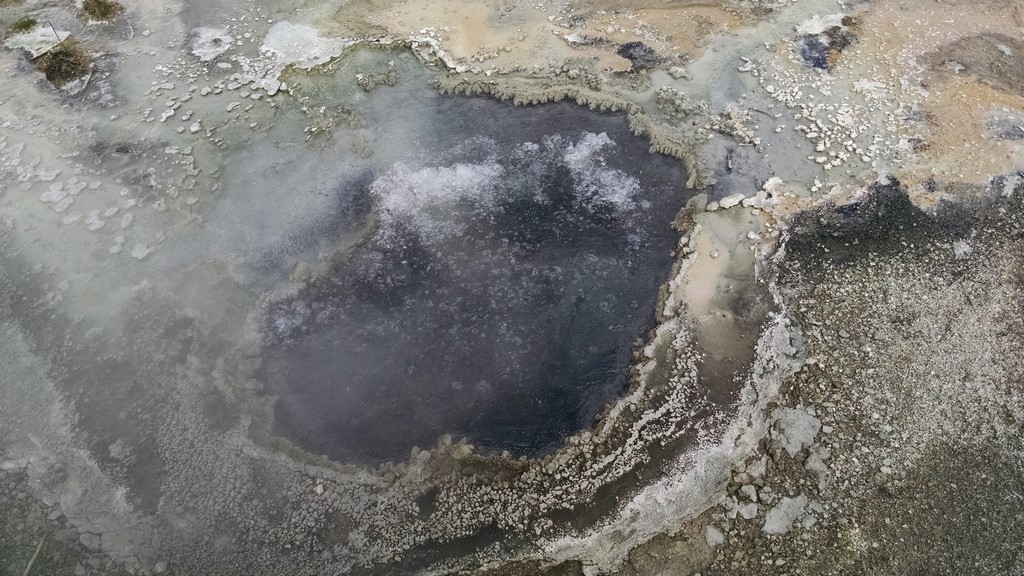Water Emotion

Our early-summer trip to Yellowstone National Park was a revelation to me, pure and simple. As I related in my Travelogue for July 22 (click here), the thing that occurred to me is that the inspiration at Yellowstone comes less from grandeur (although there’s plenty of that to go around) than it does from tiny details – little flows, minor changes in colors, subtle distinctions in texture.
My focus last time was on solid stuff, including rock formations, surface textures, colors and the like. This time, I want to focus on the water – and specifically on the variety of ways it flows at various points around the park and, even more specifically, about the way it flows in and around geysers.
Yellowstone is largely defined by water, from the rivers that amble across the terrain to its giant lake, numerous waterfalls and all sorts of streams and collecting pools and various minor waterfeatures. All of the appreciation that would ordinarily be accorded these vistas, however, was literally overwhelmed for me by the impressions made by the park’s geysers and assorted other geothermal vents.
I’d seen geysers before (in New Zealand, many years ago), but I’d never seen so many as I saw at Yellowstone – and certainly not enough to develop a sense of their variety and the strange ways in which they surprise at every encounter. Here, in this one volcanically active corner of Wyoming, the geothermal waterfeatures range in scale from negligible burblings to grand fountain displays; in action from the regular to the entirely random; in visual interest from pig-poke homely to geode-like magnificence; and in fascination from the mild to the awesome.
Regardless of basic appearance, however, every, single one of the dozens upon dozens we saw held our interest and had its lesson to teach about how water emerges and flows in nature. And the cool thing is, more so than in most places around the globe, the landscape they influence is constantly changing in substantive ways that are almost visible to the naked eye. It’s a wonderful set of recognitions, mixed with a not-unreasonable concern that things can get uncomfortable in a hurry.
|
Visual Gallery Here are some samples from among the hundreds of available Yellowstone geyser videos. * For a nice, quick survey, click here. * For information on the last eruption of the world’s highest-reaching geyser, click here. * For access to 20 spectacular videos of geyser eruptions and more, click here. — J.M. |
In the sidebar at right, I’ve set up links to a few videos featuring some of the park’s geysers, very few of which operate on schedules regular enough that you can be sure to see them if you visit. We were around for five days and were lucky enough to see our share of eruptions great and small, but by no means was all of our curiosity directly satisfied.
As you watch the videos, please consider (as we did) the immense forces at work in these displays. They’re like the relief valves on pressure cookers, and the more you hang around, the greater is the sense that being in the park if something truly unpredicted happened would be a life-altering experience. One of my favorite places was the hill where, just a few years ago, a vent opened beneath a tree-lined slope and raised the soil temperature to above 200 degree F, killing thousands of trees. At that point, the sensation that your feet are warmer in certain areas of the park is somewhat disquieting. But inspirational, too!
I have to say that I’ve never seen a watershape that was meant to mimic a geyser in any sort of literal way. (I take that back: I can think of one not-very-successful attempt with a fountain at a museum the name of which I won’t mention.) But at this point, I have to wonder why not? Why haven’t replications of these effects been attempted with some frequency?
Not all of the park’s geysers look or act like Old Faithful, which I concede is an overly vast and intimidating model. But many of the smaller geysers produce amazing interplays of rock, water and steam that could set the pattern for a fine watershape. And the judicious use of fog systems would only complete the picture.
I could go on, but suffice it to say Yellowstone should be on your list of “must” places to see – and now’s the time, because if the geologists are correct, everything about this volcanic ground could change overnight in ways nobody wants to consider.
It’s priceless: Just go!










